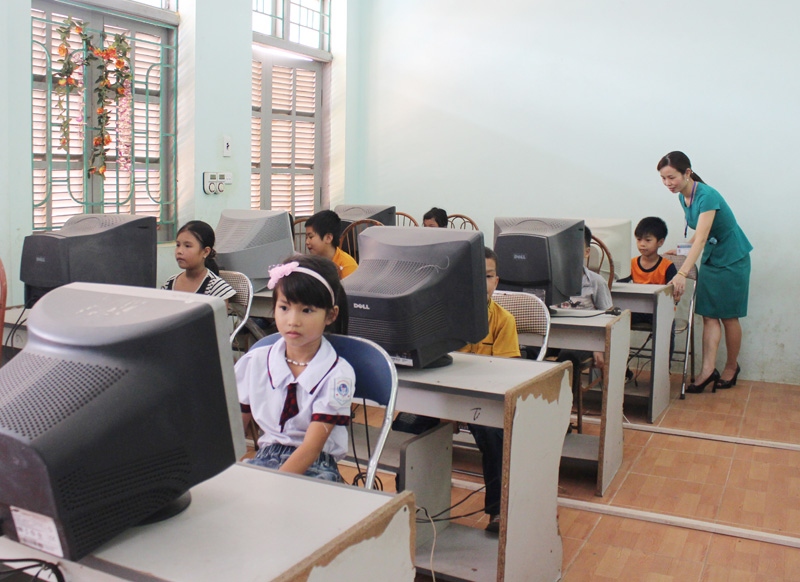
(HBO) - 100% of the educational institutions have been connected to the high-speed internet connection (82.6% have been connected to FTTH broadband connection, the rest is 3G), 84.4% of the educational institutions have been connected to LAN and wifi, 55% of the educational facilities have computer classrooms, 47% of the general educational facilities have multi-purpose projection rooms.
The equipment has been invested synchronously with sufficient quantity in accordance with the needs of each educational institution. These are the clear evidence for the policy that the sector of Education and Training has focused on promoting the application of IT in schools in the past time.
 The computer rooms of My Hoa primary school (Kim Boi) have helped the children access to IT and love for going to school.
The computer rooms of My Hoa primary school (Kim Boi) have helped the children access to IT and love for going to school.
The sector of Education and Training has directed the schools to actively promote and use effectively the infrastructure system that has been invested. The application of IT in the innovation of the content and teaching methods has been focused. In the 2018-2019 school year, nearly 9% of the lessons was taught with the support of IT. E-learning lectures are being synthesized and re-compiled to prepare for Internet access so that the teachers and the students can access. In addition, 87 secondary schools have participated in the YouthSpark Digital Inclusion project, which initially provide teaching and learning programs for the computer applications and the computer science with good effectiveness.
In particular, the pilot implementation of the experimental science and technology on the foundation of Micro:bit in schools in Mai Chau district initially have encouraging results. The district has organized an exchange of experience of science and technology creation with the attention of 30 products.
Mr. Bui Trong Dac, the Director of the Department of Education and Training, says that the sector of Education and training has also increased the application of IT in management and administration. The basic information systems for management and administration such as email, website, online meeting are maintained stable and upgraded, meeting the management needs of the whole sector. The system of the whole sector’s database on education and training has been formed, used stably and effectively exploited. 100% of the general education institutions have used the system of the school management information.
In the coming time, the sector of Education and Training will review and allocate the primary schools with the adequate informatics classrooms to implement the new general education program. At the same time, they will review, repair, upgrade, maintain and effectively use the system of the facilities and the information technology equipment to serve the deployment of the system of training and retraining teachers through the network of the Ministry of Education & Training.
The emulation movement "Hoa Binh joining hands to build new-style rural areas” has been widely spreading, becoming a driving force that motivates the localities to renew rural landscapes and improve the material and spiritual lives of the residents. In this movement, the people play a central role-both as the main implementers and direct beneficiaries of its outcomes.
In response to the global digital revolution, Hoa Binh Newspaper is transforming itself into a modern and multi-platform media hub, blending cutting-edge technology with a restructured newsroom and a new generation of tech-savvy journalists.
Hoa Binh province’s Association of the Elderly recently held a conference to review the project on expanding the inter-generation self-help club model until 2025.
In a move to implement Resolution No. 57-NQ/TW, issued on December 22, 2024 by the Politburo, which targets breakthroughs in science-technology development, innovation, and digital transformation, the Hoa Binh provincial Department of Health has issued a plan to roll out the "Digital Literacy for All” campaign within the local health sector.
An Nghia Commune (Lạc Sơn District) is one of the communes that achieved the tha standard of the national new rural area in 2018. Entering a new development phase, the commune is now trying to meet the criteria for the advanced new rural development. With the strong political will and the public consensus, the commune is gradually overcoming the challenges to reach this goal, aiming for the sustainable development.



 The computer rooms of My Hoa primary school (Kim Boi) have helped the children access to IT and love for going to school.
The computer rooms of My Hoa primary school (Kim Boi) have helped the children access to IT and love for going to school.